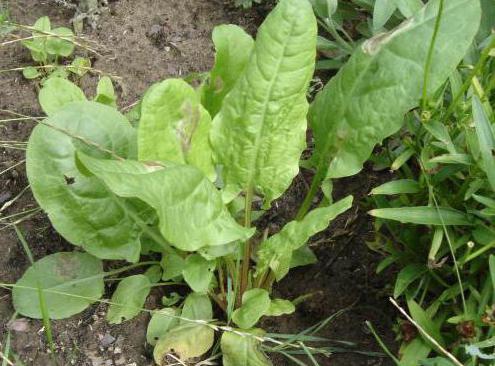Sour sorrel is a well-known and widespread plant belonging to the buckwheat family. In total, there are about 200 species. Most are weed plants. In the wild they grow in meadows, edges, glades, in sparse forests and on grassy slopes. Sorrel grows throughout Russia: near lakes, in vegetable gardens. Geographically observed in Siberia, the Caucasus, Ukraine and even the Far East.
Sour sorrel: a botanical description
A perennial plant extends up to a meter high. Its stems branch very strongly. Leaves, depending on location, vary in shape. The leaves that are located at the top are called sessile and have a more elongated appearance. And those that are below are petiolate. There are arrow-shaped leaves at the very base of the stem. Sorrel flowers are red and yellow and collected in a panicle. Flowering of this plant occurs in late spring and lasts until June. The nut on the red leg is the fruit of sour sorrel. The root system is rod, branched, thin, in the upper layer of the soil creates a rhizome.

The size of the upper part of the root in diameter is 10-15 mm, the depth is 25 cm. The lateral branches of the root are thin. New shoots form on its head, from which later rosettes with leaflets appear. They have their own fibrous root system, which consists of thin lateral branches. In length - up to 10-15 cm. The main part of the roots is in the arable line (0-25 cm). The separated branches pierce 35-40 cm deep. The uniqueness of the sorrel root is that it accumulates many nutrient enzymes, so the plant tolerates winter frosts well. But if the street is minus 15 degrees and there is no snow cover, then the plant freezes and dies.
Growing
Sour sorrel (photo of the plant is presented in the article) is frost-resistant, for its cultivation, the soil must be moist, fertile and clean. Better if it is sandy loam or loam. He also prefers soil that is well fertilized with humus. It grows well on peat and drained lands. Sowing seeds occurs in summer, spring, and even before winter. In the summer, the plant must be regularly watered. Landing in the winter is carried out in October - November. At such a late time, seeds are sown only because before the onset of severe frosts the seeds will not have time to sprout. At this time, sour sorrel is best sown where the climate is temperate. Seeds are recommended to be planted with beds to a depth of 2 cm. Already after a week and a half sprouts will be visible, and after another three - the plant can be used for their own purposes.
Care
A year after sowing, sorrel soil must be loosened regularly and weed away from weeds. Also, the grass must be systematically fertilized, protected from pests. A month before frost, the leaves need to be cut. In autumn, it is better to plant humus or compost in the soil of the plant. After a year of sowing, mineral fertilizers can be applied, but only in small quantities, otherwise the plant may burn out.
Medicinal and nutritional value
The value of this plant is that it contains a lot of chemical compounds necessary for the human body. Therefore, we should first of all find out and remember what is contained in the sorrel and how useful its composition is to humans. Its components:
- water - 91%;
- proteins - 2.3%;
- fats - 0.5%;
- carbohydrates - 2.6%;
- dietary fiber - 0.8%;
- organic acids - 0.9%;
- ash - 1.4%.
The composition of acid sorrel includes macroelements: a complex of calcium, potassium, magnesium, sodium, sulfur, phosphorus, chlorine. Trace elements - a complex of iron, iodine, manganese, copper, zinc, fluorine. The plant is rich in vitamins such as: A, B1, B2, B3 / PP, B5, B9 - folic acid, C, E, K - phylloquinone; H is biotin.
Sour sorrel: a description of the plant, useful properties
Sorrel has an analgesic effect, its infusion is used for painful menstruation. In addition, you can float with low back pain. The chemical composition of this plant allows you to use with cystitis, also sorrel has antifungal and choleretic properties. It has long been known that this amazing plant can stop the blood, so feel free to compress the wounds that bother you.
Sour sorrel (description above) is a good astringent drug that is used for diarrhea and dysentery in young children. A decoction of sorrel can treat furunculosis and other fungal diseases on the head. Juice from it has an excellent effect on the body for preventive purposes: from scabies, rheumatism, fever and other diseases. A decoction from this plant is used as a rinse for sore throat and bleeding gums.
Sorrel in folk medicine
The plant has healing power, so it has long been used in folk medicine. Rich in organic acids and vitamins of certain groups, it can not only treat diseases, but also prevent their development.
This plant is unique in nature, therefore it has a good effect on the intestines and positively affects the metabolic process in the human body. Sorrel contains ascorbic acid, which treats vitamin deficiency and removes cholesterol. A decoction of the leaves is recommended to be used as an antidote for certain types of poisoning. Sorrel is also used for hemorrhoids, colitis and inflammation of the gastrointestinal tract.
Cooking use
Sour sorrel (photo can be seen in the article) is very well used in cooking. It is used in fresh, pickled, canned or dried form, added to vitamin salads, soups and borsch, and even in the form of a filling for pies. The leaves of this plant are very nutritious and healthy, and all because of malic and citric acid. It is important to note that it is best to eat it only until July, since in a later period a lot of oxalic acid is collected in it, which is hazardous to health.
Contraindications
This plant categorically can not be used during pregnancy and lactation. Remember that frequent consumption of sour sorrel (a photo will help to recognize it) can lead to the formation of kidney stones. It is not recommended for gastritis with high acidity and gastric ulcer.
Sorrel should not be abused, as it leads to toxic effects on the body. As a result, a person may develop diarrhea, nausea, and a pathology of the urinary system. Remember that acid sorrel affects the absorption of calcium, which can lead to osteoporosis.
Useful recipes
Represent the most common:
- A broth of roots for the prevention of hemorrhoids. It is necessary to take the root of the sorrel, one large spoon, pour hot water, boil for half an hour. After that, remove the product from the fire, filter. You need to drink one spoon in the morning, lunch and evening. The broth is also advised to apply for bowel cracks, colitis.
- Infusion of sour sorrel from blood diarrhea. You need to take dry fruits - about one tablespoon - and pour hot water in the bowl. Boil for 15 minutes, then insist for an hour. It must be taken for breakfast, lunch and dinner, 50 ml.
- Decoction of sorrel seeds for the prevention of burns. Take grains, 15 grams, 100 ml of water, boil everything for about half an hour. The broth should be used to treat bedsores. It is advised to take inside no more than a tablespoon at a time.
- This plant heals ulcers and wounds well. It is necessary to collect the leaves of the plant, rinse them and attach to an open wound. You will very quickly notice how the inflammation will go away, the skin will become better.
- Sorrel is excellent in treating tonsillitis. You need to make a means to gargle. It is necessary to cook a fresh stalk and leaves of sorrel, then pour everything with boiling water. Then the composition must be finely chopped and a porridge made with a wooden spoon. Then take cheesecloth and squeeze the juice. It is necessary to take in strict dosages - no more than a tablespoon at a time.

Finally
So, we found out that sorrel has been used as a medicinal plant since ancient times. It is taken orally as a decoction, tincture, juice for various diseases. Sorrel is very useful for external use. It helps to heal serious wounds, burns, bedsores and other skin diseases. Despite the positive properties of the plant, it is better to be extremely careful with the sorrel, since it has side effects.